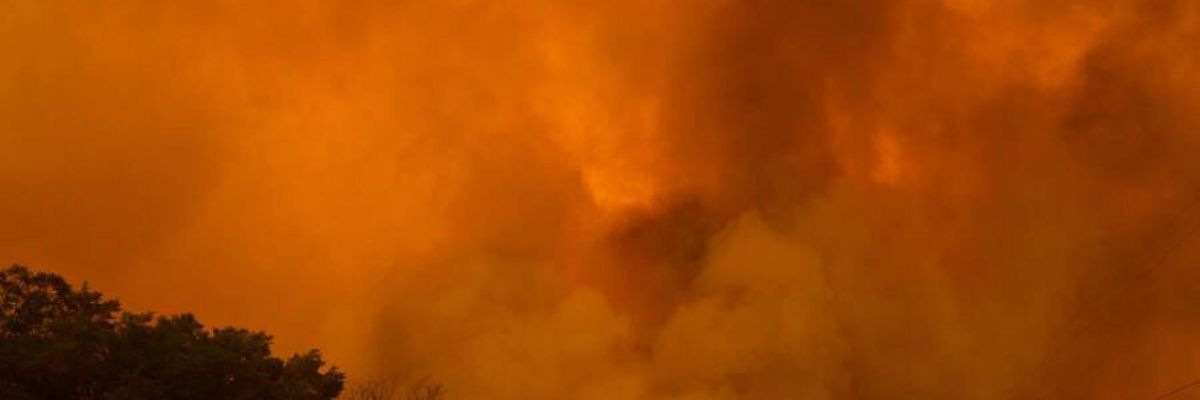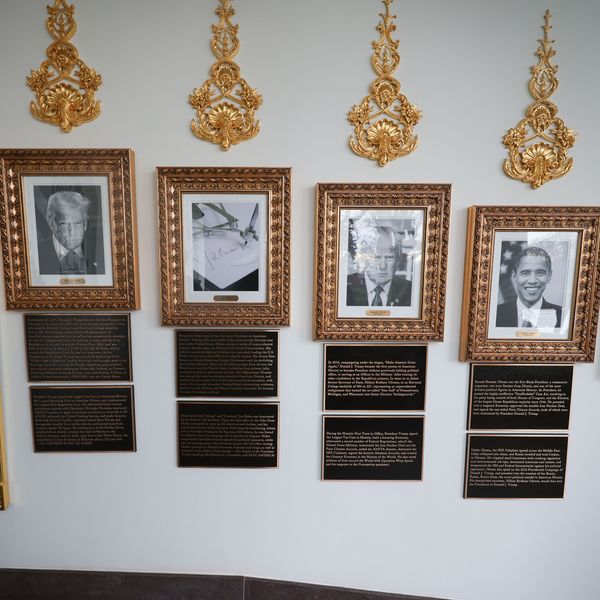
Firefighters try to stop the Dixie Fire from crossing Highway 395 on August 17, 2021 near Milford, California. (Photo: Patrick T Fallon/AFP via Getty Images)
Welcome to the Pyrocene: Fossil Fuel Combustion Has Thrust Us Into a New Fire Age
Our fires in living landscapes and those made with fossil fuels have been reshaping the Earth. The result is too much bad fire and too little good, and way too much combustion overall.
Fire in the West is expected, and not so long ago, it seemed something the West experienced more than anywhere else. Nationally, big fires were treated as another freak of Western violence, like a grizzly bear attack, or another California quirk like Esalen and avocados.
We have a lot of fire in our future, and a lot to learn about living with it.
Now the wildland fires flare up everywhere. There are fires in Algeria and Turkey, Amazonia and Indonesia, and France, Canada, and Australia. Last year even Greenland burned.
Fire seasons have lengthened, fires have gotten meaner and bigger; fires have begun not just gorging on logging slash and prowling the mountainous backcountry, but also burning right into and across towns. Three years ago in northern California, the Camp Fire broke out along the Feather River and, burning southwest, incinerated the town of Paradise. Now, the Dixie Fire, starting 20 miles north in the same drainage, is burning in the opposite direction, taking out the historic town of Greenville. The fires have us coming and going.
The causes have been analyzed and reanalyzed, like placer miners washing and rewashing tailings. Likewise, the solutions have been reworked and polished until they have become cliches, ready to spill into the culture wars.
The news media have fire season branded into their almanac of annual events. Scientific disciplines are publishing reports and data sets at an exponential rate. So far as understanding the fire scene, we've hit field capacity. What more can we say?
One trend is to go small and find meaning in the personal. But there is also an argument to go big and frame the story at a planetary scale that can shuffle all the survival memoirs, smoke palls that travel across the continent, melting ice packs, lost and disappearing species, and sprawling frontiers of flame, in much the way we organize the swarm of starlight in a night sky into constellations.
I'm a fire guy. I take fire not just as a random happening, but as an emergent property that's intrinsic to life on Earth.
So I expect fires. All those savanna fires in Africa, the land-clearing fires in Brazil and Sumatra, the boreal blowouts in Siberia and British Columbia, the megafires in the Pacific Northwest--all the flames we see.
But then there are fires that should be present and aren't--the fires that once renewed and stabilized most of the land all over our planet. These are the fires that humanity, with its species monopoly on combustion, deliberately set to make living landscapes into what the ancients termed "a second nature."
But it was not enough. We wanted yet more power without the constraints of living landscapes that restricted what and when we could burn. We turned to fossil fuels to burn through day and night, winter and summer, drought and deluge. With our unbounded firepower we remade second nature into "a third nature," one organized around industrial combustion.
Our fires in living landscapes and those made with fossil fuels have been reshaping the Earth. The result is too much bad fire and too little good, and way too much combustion overall.
Add up all those varieties of burning, and we seem to be creating the fire equivalent of an ice age, with continental shifts in geography, radical changes in climate, rising sea level, a mass extinction, and a planet whose air, water, soil and life are being refashioned at a breakneck pace.
It's said that every model fails but some are useful. The same holds true for metaphors. What the concept of a planetary Fire Age--a Pyrocene--gives us, is a sense of the scale of our fire-powered impact. It suggests how the parts might interact and who is responsible. It allows us to reimagine the issues and perhaps stand outside our entrenched perspectives.
What we have made--if with unintended consequences--we can unmake, though we should expect more unknown consequences.
We have a lot of fire in our future, and a lot to learn about living with it.
An Urgent Message From Our Co-Founder
Dear Common Dreams reader, The U.S. is on a fast track to authoritarianism like nothing I've ever seen. Meanwhile, corporate news outlets are utterly capitulating to Trump, twisting their coverage to avoid drawing his ire while lining up to stuff cash in his pockets. That's why I believe that Common Dreams is doing the best and most consequential reporting that we've ever done. Our small but mighty team is a progressive reporting powerhouse, covering the news every day that the corporate media never will. Our mission has always been simple: To inform. To inspire. And to ignite change for the common good. Now here's the key piece that I want all our readers to understand: None of this would be possible without your financial support. That's not just some fundraising cliche. It's the absolute and literal truth. We don't accept corporate advertising and never will. We don't have a paywall because we don't think people should be blocked from critical news based on their ability to pay. Everything we do is funded by the donations of readers like you. Will you donate now to help power the nonprofit, independent reporting of Common Dreams? Thank you for being a vital member of our community. Together, we can keep independent journalism alive when it’s needed most. - Craig Brown, Co-founder |
Fire in the West is expected, and not so long ago, it seemed something the West experienced more than anywhere else. Nationally, big fires were treated as another freak of Western violence, like a grizzly bear attack, or another California quirk like Esalen and avocados.
We have a lot of fire in our future, and a lot to learn about living with it.
Now the wildland fires flare up everywhere. There are fires in Algeria and Turkey, Amazonia and Indonesia, and France, Canada, and Australia. Last year even Greenland burned.
Fire seasons have lengthened, fires have gotten meaner and bigger; fires have begun not just gorging on logging slash and prowling the mountainous backcountry, but also burning right into and across towns. Three years ago in northern California, the Camp Fire broke out along the Feather River and, burning southwest, incinerated the town of Paradise. Now, the Dixie Fire, starting 20 miles north in the same drainage, is burning in the opposite direction, taking out the historic town of Greenville. The fires have us coming and going.
The causes have been analyzed and reanalyzed, like placer miners washing and rewashing tailings. Likewise, the solutions have been reworked and polished until they have become cliches, ready to spill into the culture wars.
The news media have fire season branded into their almanac of annual events. Scientific disciplines are publishing reports and data sets at an exponential rate. So far as understanding the fire scene, we've hit field capacity. What more can we say?
One trend is to go small and find meaning in the personal. But there is also an argument to go big and frame the story at a planetary scale that can shuffle all the survival memoirs, smoke palls that travel across the continent, melting ice packs, lost and disappearing species, and sprawling frontiers of flame, in much the way we organize the swarm of starlight in a night sky into constellations.
I'm a fire guy. I take fire not just as a random happening, but as an emergent property that's intrinsic to life on Earth.
So I expect fires. All those savanna fires in Africa, the land-clearing fires in Brazil and Sumatra, the boreal blowouts in Siberia and British Columbia, the megafires in the Pacific Northwest--all the flames we see.
But then there are fires that should be present and aren't--the fires that once renewed and stabilized most of the land all over our planet. These are the fires that humanity, with its species monopoly on combustion, deliberately set to make living landscapes into what the ancients termed "a second nature."
But it was not enough. We wanted yet more power without the constraints of living landscapes that restricted what and when we could burn. We turned to fossil fuels to burn through day and night, winter and summer, drought and deluge. With our unbounded firepower we remade second nature into "a third nature," one organized around industrial combustion.
Our fires in living landscapes and those made with fossil fuels have been reshaping the Earth. The result is too much bad fire and too little good, and way too much combustion overall.
Add up all those varieties of burning, and we seem to be creating the fire equivalent of an ice age, with continental shifts in geography, radical changes in climate, rising sea level, a mass extinction, and a planet whose air, water, soil and life are being refashioned at a breakneck pace.
It's said that every model fails but some are useful. The same holds true for metaphors. What the concept of a planetary Fire Age--a Pyrocene--gives us, is a sense of the scale of our fire-powered impact. It suggests how the parts might interact and who is responsible. It allows us to reimagine the issues and perhaps stand outside our entrenched perspectives.
What we have made--if with unintended consequences--we can unmake, though we should expect more unknown consequences.
We have a lot of fire in our future, and a lot to learn about living with it.
Fire in the West is expected, and not so long ago, it seemed something the West experienced more than anywhere else. Nationally, big fires were treated as another freak of Western violence, like a grizzly bear attack, or another California quirk like Esalen and avocados.
We have a lot of fire in our future, and a lot to learn about living with it.
Now the wildland fires flare up everywhere. There are fires in Algeria and Turkey, Amazonia and Indonesia, and France, Canada, and Australia. Last year even Greenland burned.
Fire seasons have lengthened, fires have gotten meaner and bigger; fires have begun not just gorging on logging slash and prowling the mountainous backcountry, but also burning right into and across towns. Three years ago in northern California, the Camp Fire broke out along the Feather River and, burning southwest, incinerated the town of Paradise. Now, the Dixie Fire, starting 20 miles north in the same drainage, is burning in the opposite direction, taking out the historic town of Greenville. The fires have us coming and going.
The causes have been analyzed and reanalyzed, like placer miners washing and rewashing tailings. Likewise, the solutions have been reworked and polished until they have become cliches, ready to spill into the culture wars.
The news media have fire season branded into their almanac of annual events. Scientific disciplines are publishing reports and data sets at an exponential rate. So far as understanding the fire scene, we've hit field capacity. What more can we say?
One trend is to go small and find meaning in the personal. But there is also an argument to go big and frame the story at a planetary scale that can shuffle all the survival memoirs, smoke palls that travel across the continent, melting ice packs, lost and disappearing species, and sprawling frontiers of flame, in much the way we organize the swarm of starlight in a night sky into constellations.
I'm a fire guy. I take fire not just as a random happening, but as an emergent property that's intrinsic to life on Earth.
So I expect fires. All those savanna fires in Africa, the land-clearing fires in Brazil and Sumatra, the boreal blowouts in Siberia and British Columbia, the megafires in the Pacific Northwest--all the flames we see.
But then there are fires that should be present and aren't--the fires that once renewed and stabilized most of the land all over our planet. These are the fires that humanity, with its species monopoly on combustion, deliberately set to make living landscapes into what the ancients termed "a second nature."
But it was not enough. We wanted yet more power without the constraints of living landscapes that restricted what and when we could burn. We turned to fossil fuels to burn through day and night, winter and summer, drought and deluge. With our unbounded firepower we remade second nature into "a third nature," one organized around industrial combustion.
Our fires in living landscapes and those made with fossil fuels have been reshaping the Earth. The result is too much bad fire and too little good, and way too much combustion overall.
Add up all those varieties of burning, and we seem to be creating the fire equivalent of an ice age, with continental shifts in geography, radical changes in climate, rising sea level, a mass extinction, and a planet whose air, water, soil and life are being refashioned at a breakneck pace.
It's said that every model fails but some are useful. The same holds true for metaphors. What the concept of a planetary Fire Age--a Pyrocene--gives us, is a sense of the scale of our fire-powered impact. It suggests how the parts might interact and who is responsible. It allows us to reimagine the issues and perhaps stand outside our entrenched perspectives.
What we have made--if with unintended consequences--we can unmake, though we should expect more unknown consequences.
We have a lot of fire in our future, and a lot to learn about living with it.

